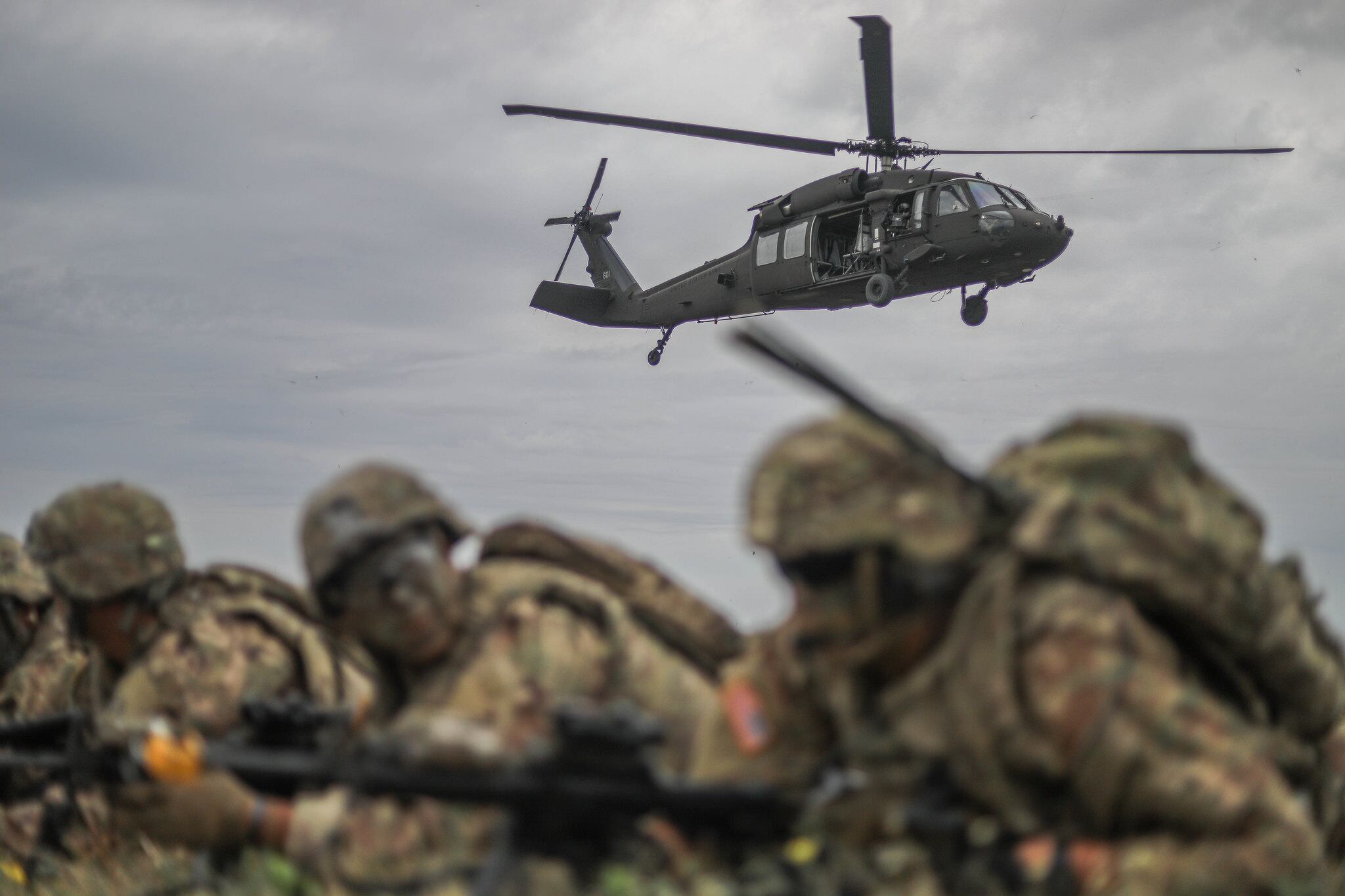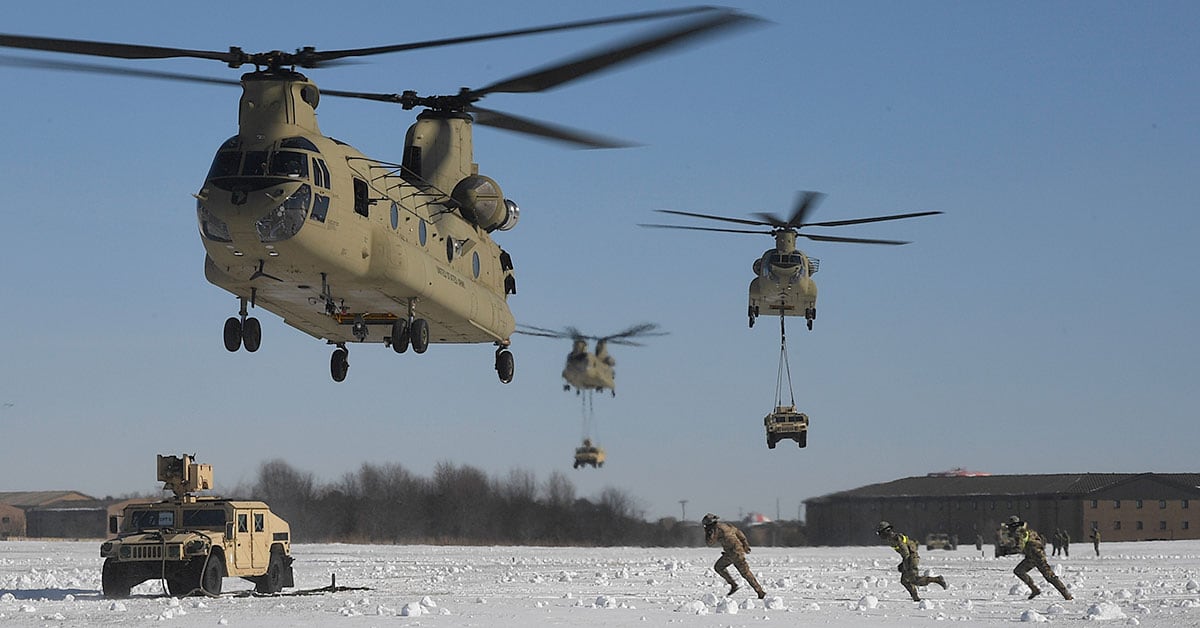WASHINGTON — As we look to 2019, a handful of programs will see some overdue movement in the first part of the year. Among them is the Improved Turbine Engine Program — the U.S. Army’s effort to to design and develop a new engine to power both existing helicopters and the vehicles developed as part of the Future Vertical Lift program.
General Electric and a joint venture of Honeywell and Pratt & Whitney are each vying for the win with different solutions: the former an improved version of the existing single-spool engine (one turbine-compressor system), which is already in the Army’s UH-60 Black Hawk and AH-64 Apache helicopter fleets; and the latter a dual-spool engine (two turbine-compressor systems).
RELATED

Defense News spoke to two members of the GE team in December — executive director of the T901 program, Ron Hutter, and Mike Sousa, business development leader for advanced turboshaft engines — to see where the program stands and how the company feels about its chances of securing a contract.
We’ve been awaiting an update on the ITEP program. What’s the latest?
Ron Hutter: This program started as an S&T program back in 2007, then progressed into the next phase, which was the technical maturation, or risk-reduction program phase, which we received the contract for in 2016. That was, at the time, 24 months, now 30 months contracts to basically come up with a preliminary design for the engine and get that approved before going into [the engineering and manufacturing development] phase. So we went through that earlier this year, got our preliminary design review approved midyear by the Army. So, we’re well on the way to finishing that contract early next year.
The request for proposals [for the engineering and manufacturing development phase] came out in November of last year. And so we spent the last year, essentially, responding to that RFP. It was in several phases. We submitted proposals in February of this year, and then in July of this year. And we submitted our final proposal revision at the end of October. So we’ve essentially been going back-and-forth with the Army on responses to their RFP for the last year. And we’re anticipating an announcement of a down-select between ourselves or our competition, who the winner will be, in the January/February time frame of next year.
In terms of ultimate goals of the Army, it seems to come down to fuel efficiency and power. So, before we dig into the actual technology, can you speak to, in terms of operations, what is driving the Army’s need here?
Mike Sousa: When the Army launched this program back a decade ago, they had power and weight goals, they had specific fuel consumption goals, and then they had affordability goals. One of the things that’s made it really easy for us to work this program is that they haven’t varied those goals very much. They asked for a 3,000 shaft horsepower engine all the way back a decade ago, and we haven’t had to resize engines or anything to meet the Army requirements. They looked at what they needed to do to meet the goals, the requirements with Black Hawk and Apache, and they said: “Hey, it’s got to fit in the same helicopter, weigh the same, but be at 3,000 shaft horsepower engine versus the 2,000 shaft horsepower engine [currently installed]. And we’d like it to be that step change in specific fuel consumption, which is about a 25 percent improvement in specific fuel consumption.” Those things will drive the capability of the helicopter.
What they were experiencing at the time was they had Black Hawk and Apache helicopters that have gotten heavier over the life of those programs. They've added things that make sense for the aircraft like armor, but that makes it harder for that engine that was designed to work in that helicopter to still have the same performance.
The other thing they were doing was they were involved in Afghanistan where they fly really hot and really high. The helicopters were originally designed to work at 4,000 feet on a 95-degree day, and they were flying them much higher than that. When you do that, you just don’t have as much power from the engine.

So they were losing capability in terms of how much payload they could carry, how far they could go, because they had heavier helicopters. Getting that capability at higher and hotter conditions than it was designed to do originally and being able to fly farther, being able to take things on longer missions, were the drivers for the program.
At the same time, they had acquisition cost pools and maintenance cost pools. And you've got to remember that the driver there was not to drive the cost of these platforms up significantly by improving the capability.
RELATED

So the requirements have not changed much since the Army initiated the program. That’s pretty unusual these days.
Sousa: There’ve been other things that have evolved over time, like cyber requirements weren’t even thought about when we launched, and certainly we had to be careful about cyber as we went through the program. But that didn’t really drive the fundamentals of what the turbo machinery of the engines were to look like.
So getting into the design a bit, the distinct difference between the offerings — between your offering and that of your competitor — is GE is offering a single-spool engine while your competitor is offering a double-spool engine. Can you talk in real terms what that means?
Sousa: You said single-spool engine was our configuration, and their configuration was a dual spool. And that gets into how you define what a spool is. And if a spool has both compressor and a turbine, then we have a single compressor in our engine, driven by the high-pressure turbine, and we also have a power turbine, which is a free-power turbine. So, there’s two shafts in our engine, where the other guys have two spools in their core, and then they have a free-power turbine. So there’s three shafts in their engine.
The configuration that we’re proposing is consistent with what the T700 has been. And what we think that does is, when we can meet the requirements with that configuration, it saves us having additional shafts and bearings and frame in the engine, which makes it for us a lot easier to meet things like the weight target and the cost target by not having that additional complexity in the engine. And so our fundamental approach there was how do we keep this engine as affordable as possible and as low weight as possible. And, when we did that, if we had the technology to meet that requirement without adding the complexity of an additional spool and an additional compressor and turbine that were independent of the ones that were in the core, then it just saves us a whole bunch of additional hardware.
Hutter: I mean, early on in the program, we did our own trade studies and looked at different architecture configurations that could meet these requirements. When we did those, we looked at single-spool, dual-spool, different types of configurations. And if you have the technology to meet the performance requirements that the Army was putting out there, it made the most sense from the cost perspective and the maintainability perspective to stick with the single-spool architecture.
Helicopters are unique in that they fly into very dirty environments, very austere environments, unprepared landing strips, unprepared surfaces. They generate a lot of dust. You really want to look at the simplicity of the architecture in terms of maintainability. That’s another aspect that drove us to stick with the single-spool configuration.
Since the requirements have been consistent, that has been our design. The T700 has proven that out in terms of the levels of readiness the Army can enjoy with that high level of maintainability with full modularity of that single-spool engine, which means access to the hot section, which is where you end up with most of your maintenance.
The single-spool core has proven itself out.
I know, obviously, you can’t necessarily know pricing for a competitor, but to what degree is it more economical going with the single variation that you offer, by comparison?
Hutter: I mean, there’s just less parts, less complexity — you can kind of figure there’s going to be a pretty significant difference between the maintenance cost, as well as the whole logistics trail that you have to go to the fight. You’re going to have to have more spare engines if you have less modular engines.
Sousa: We [also] have a whole bunch of prognostics and diagnostics built into the engine today that weren’t available when we develop the T700 engines. And so one of the things that we can do in terms of maintaining these engines is identify for the maintainer in the field where the engine is degrading, what kinds of things you can do proactively. Maybe it’s a hot-section water wash, or a cold-water wash, or looking at the performance of the compressor. Is there something you can do with the compressor in the field, [for example,] to avoid having to send the engine back to the depot?
That’s the fundamental difference between what we did with the T700.
I know there’s always the desire to be able to adapt the technology to incorporate new capabilities as new requirements evolve. Does this design allow for that?
Hutter: The architecture is not the determining factor in the growth capability for the engine. And we’ve proven that on the T700. It started off at about 1,500 shaft horsepower, and that family of engines, including our commercial variants, has doubled within the same volume of space. The only way you can do that is with technology. And so that’s the exact same plan that we have for the T901. As the technology becomes available, we’ll grow to meet requirements for FVL or for whatever the Army’s needs are going forward.
We also have the advantage of having a very large commercial engine business, and that side of our business has invested in technology for airline engines for many years. In the last decade or so, we’ve spent over $9 billion developing and accruing advanced technologies for the commercial engine side of the business. So things like ceramic matrix composites, which give you a high-temperature capability; additive manufacturing, which is a huge technology that we’re employing for the T901; 3D aero designs in the airfoils; air-cooling designs for the hot section. We’re leveraging all of this investment from our commercial engine side of the business into the T901s to meet these performance requirements.
And by the time this engine goes into service in the mid 2020s, we’ll have over 700 million hours of experience on our commercial engines with those technologies. So this will be a mature technology by that time for sure.
Jill Aitoro is editor of Defense News. She is also executive editor of Sightline Media's Business-to-Government group, including Defense News, C4ISRNET, Federal Times and Fifth Domain. She brings over 15 years’ experience in editing and reporting on defense and federal programs, policy, procurement, and technology.








